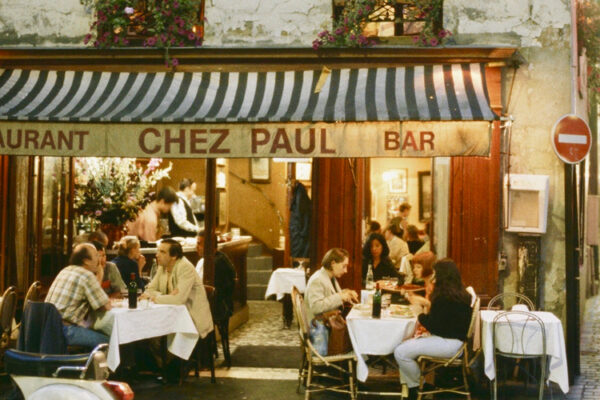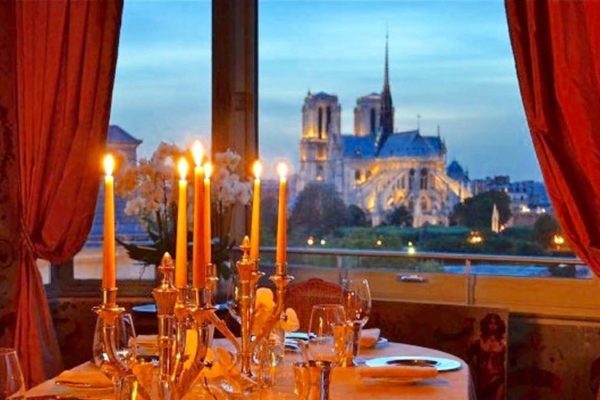Paris Block Busters: L’Arpège & Musée Rodin
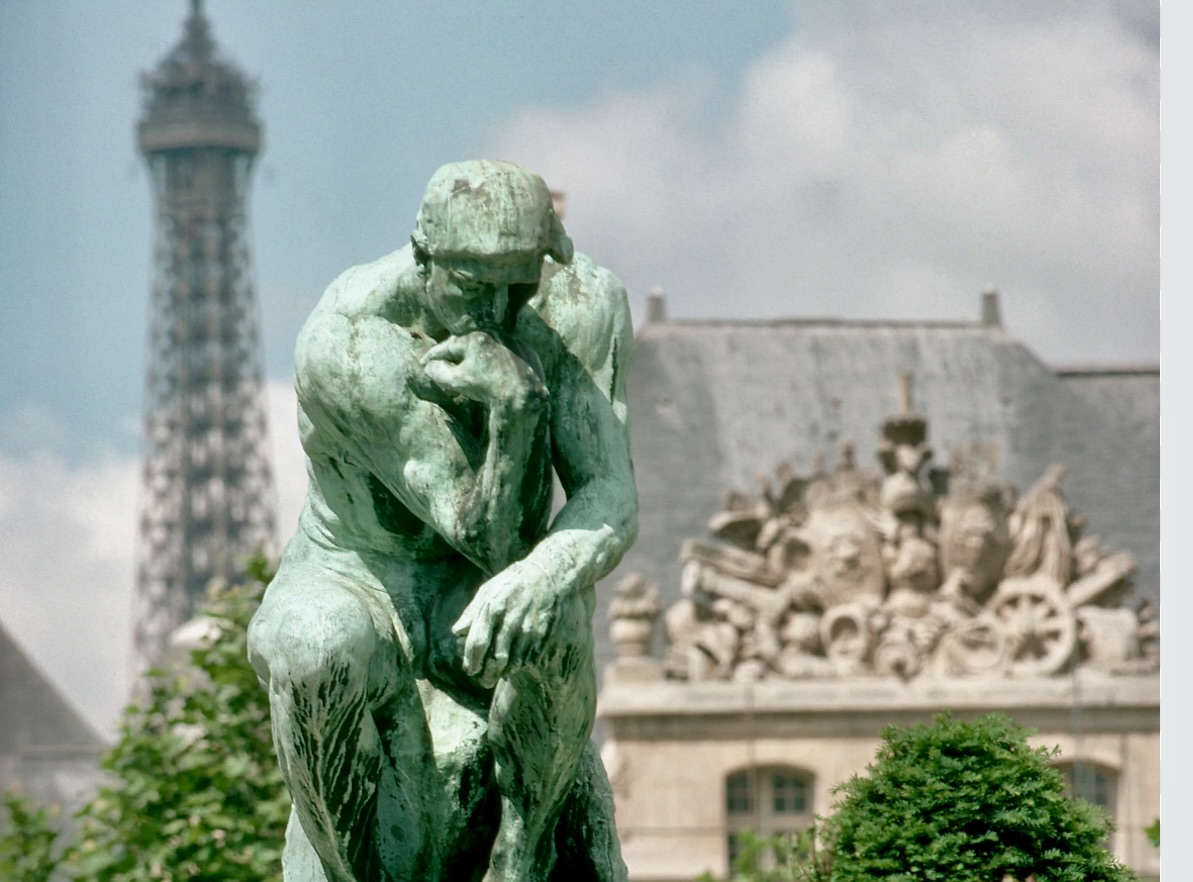
by Michel Thibault & Marla Norman
A few years back, we were traveling in Paris with a group of clients who eventually became some of our dearest friends. One evening, the group opted to go to L’Arpège, a famous 3-star Michelin restaurant. Thankfully, it was my friend Melvin’s treat…
L’Arpège is located on rue de Varenne, across from the Rodin museum, in an impressive part of town that houses the Invalides and the French National Assembly. The memory of that dinner has been in my mind ever since. Unfortunately, Marla had picked up a bad bug and was unable to accompany us, so I’ve always wanted to take her. Of course, I knew I would possibly have to mortgage the house to pay for it!
The Ambiance: As you enter L’Arpège, the decor is airy, the back wall covered with material depicting country scenes in an artful way and drawings of simple foods such as cabbages, garlic etc. The front is lined with a row of tables along the windows, benefiting from the outside light and invisible from the street. Essentially, a bourgeois house: comfortable, slightly artsy, but a place where you can already feel that the focus is on food.
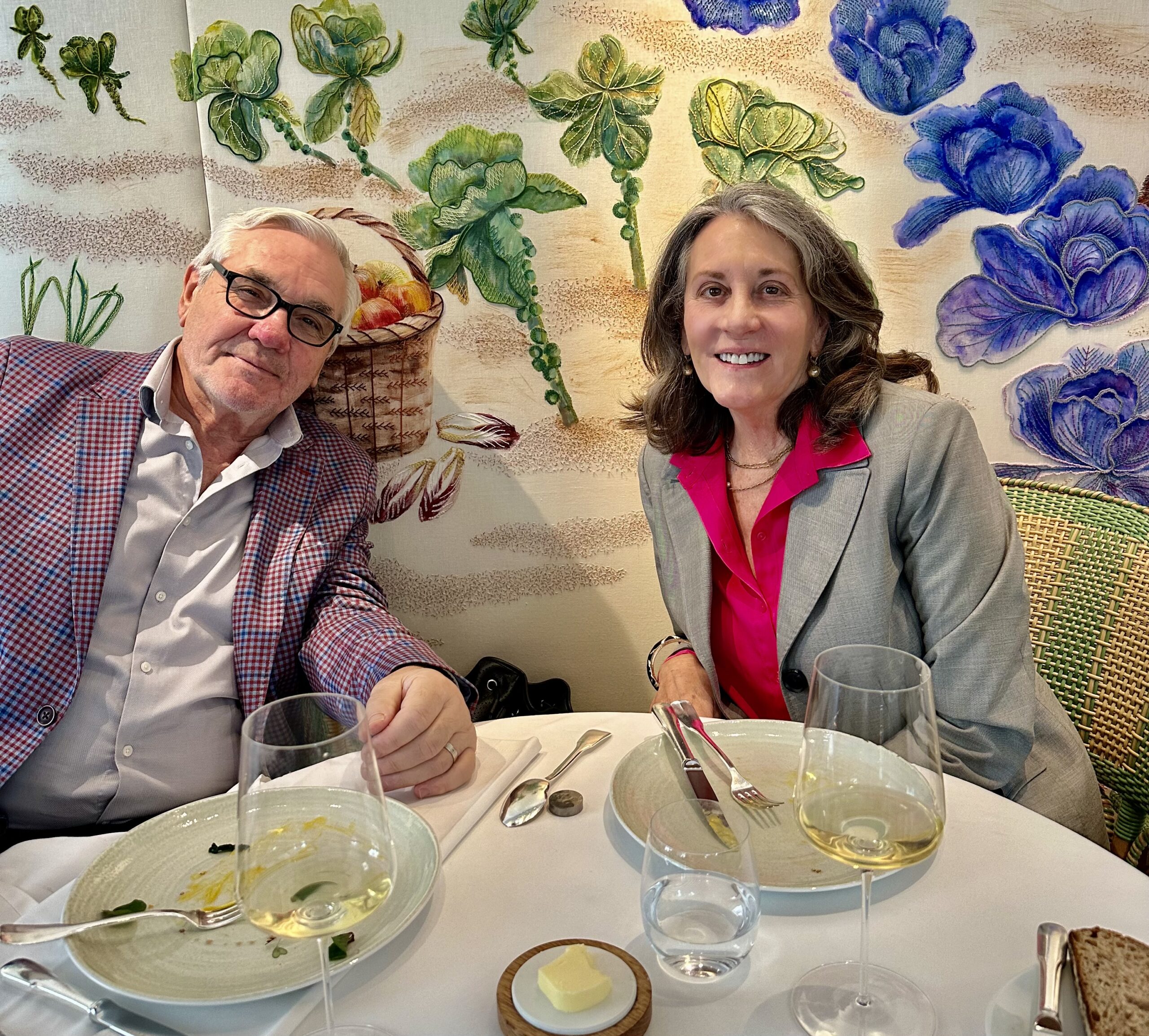
Eye-catching references to vegetables everywhere at L’Arpège.
Our table is well located (I like my back against the wall) and we can observe the staff. Having worked in a number of restaurants throughout my life, I pride myself on checking the small details that separate poor to nice to excellent service. Here, young women and men wearing impeccable suits move effortlessly around the room and work as a team. The lead waiter explains the menu (thankfully without telling us his first name) and the possible options. Later, when we meet the sommelier, we experience the same knowledgeable and helpful service.
The Menu: a nine-course possibility is available, but this is lunch and there is no way we are going there. The head waiter mentions a combo à la carte which works well for us, as we are both able to sample each dish. The wine list is very serious with excellent options as you can imagine. I pick a Pouilly Fumé (white from the Loire Valley) as these wines are both texturally amazing, like a Sancerre for freshness but with more aromatics. It’s a wine I think will match a variety of foods, but also fairly inexpensive compared to other options. Pouilly Fumé is not the fad of the moment and so usually well priced. What I really enjoy is the fact that the sommelier (one of two women sommeliers on staff) suggests a Pouilly Fumé I had not tried before — Le Saut de Lorette (according to the label, only 970 bottles were produced that vintage) and it rocks. Plus, it wasn’t any more expensive than my original choice. Good luck finding it any place else.
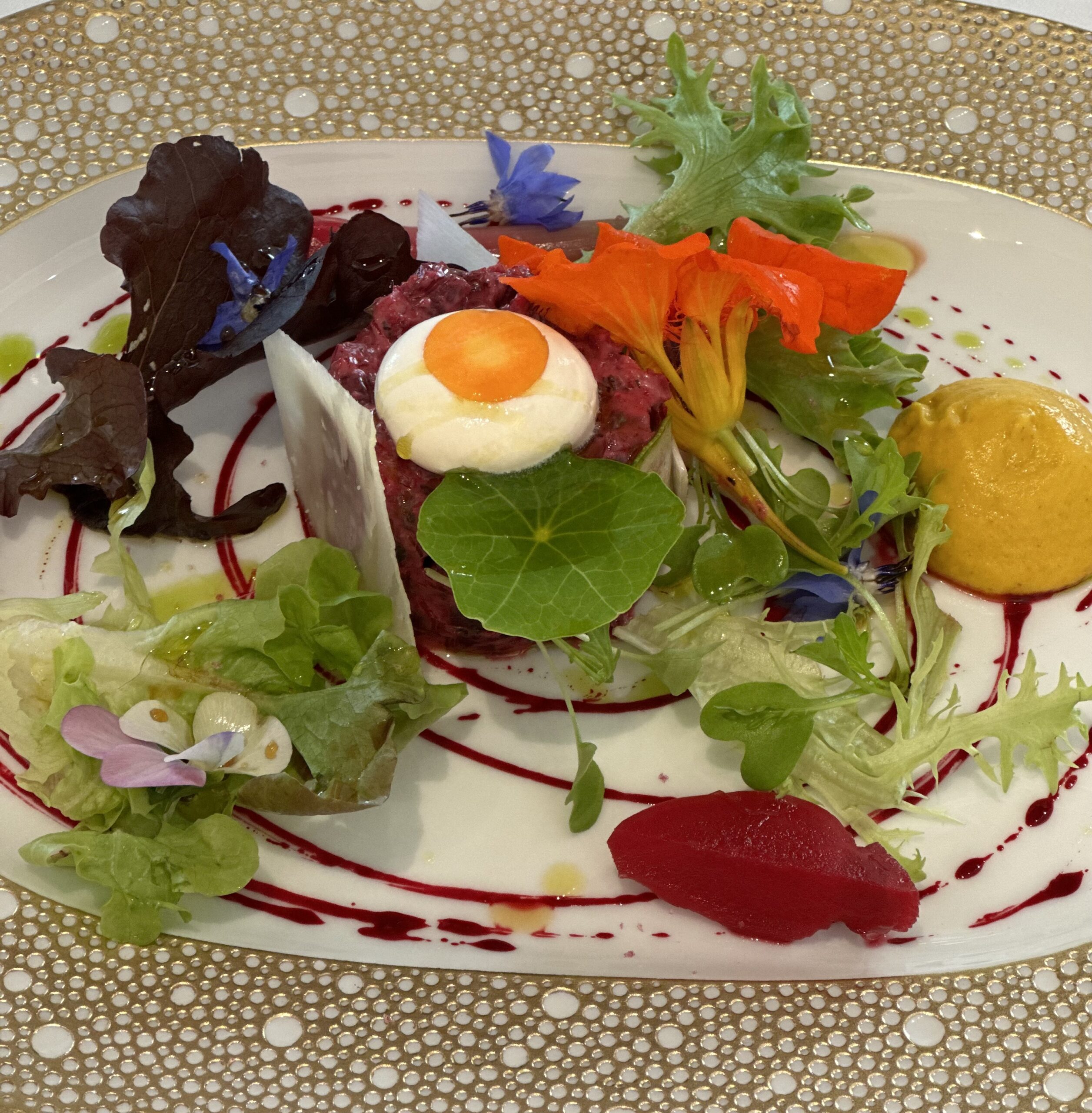
Exquisitely plated dishes at L’Arpège, including this Beetroot Tartare with a faux egg of crème fraiche and Othello tomatoes. Photos by Marla Norman.

“Eden des aromates” – creatively prepared vegetables in a golden consommé.
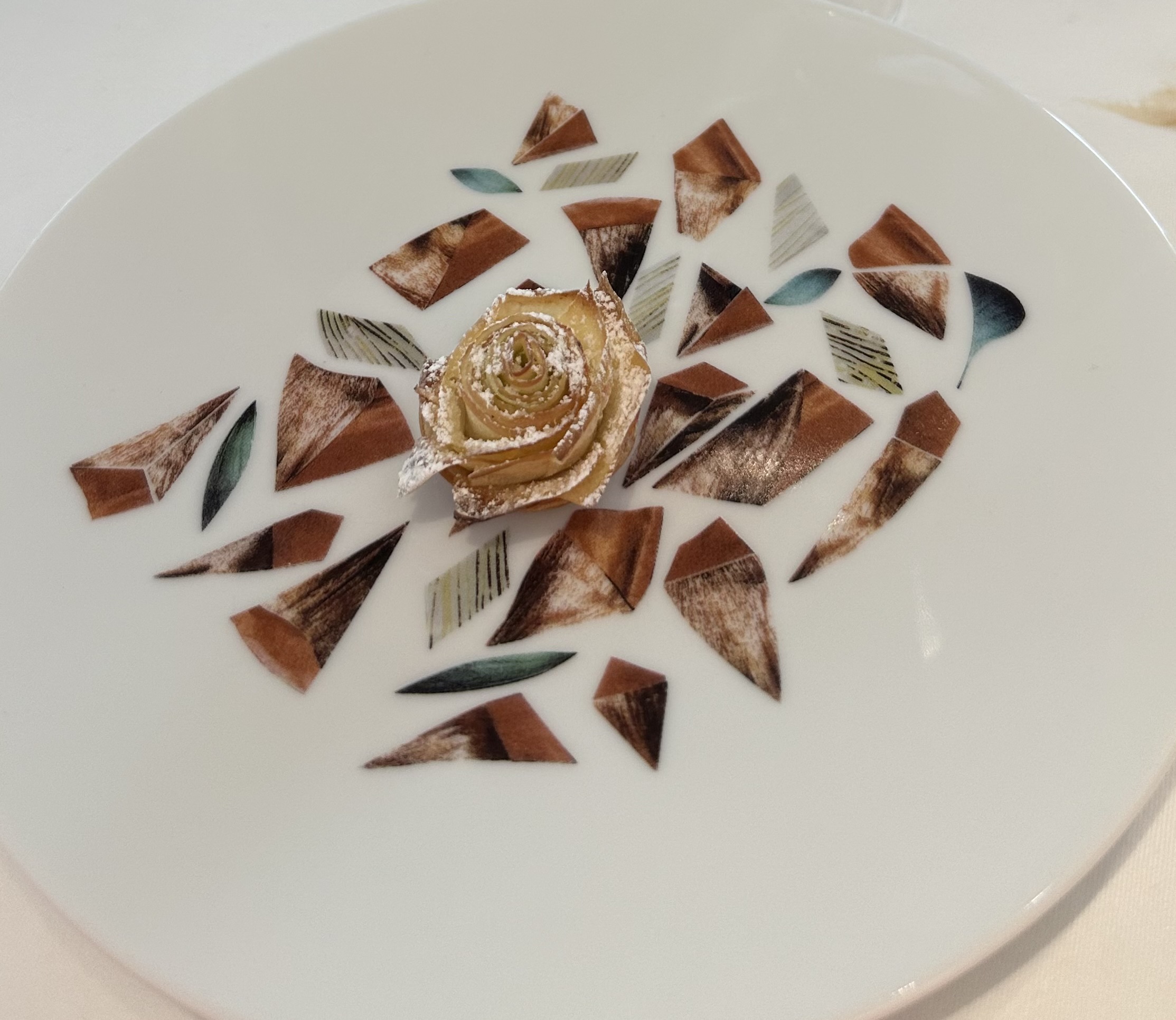
Sweet ending: Glazed candies and a sugared rose.
The Service & Food: Dishes appear in a timely fashion with a few minutes break in between. L’Arpège features mostly products from the garden (there is one fish and one lamb dish on the menu) but the genius of this restaurant in my mind is that every dish has distinctive flavors of its own which lead from one course to the next effortlessly. Decoration on the plate is superb with each food’s natural beauty being set forward without ever being ostentatious. As I look at the successive dishes, I am amazed that these basic food elements from our daily life — radishes, mushrooms, root vegetables, etc. — are married in a such a way that their natural color and flavor not only show on their own but add to each other’s aromas to make a sublime dish. Then, the following dish gives you an identical experience while the food elements are totally different!
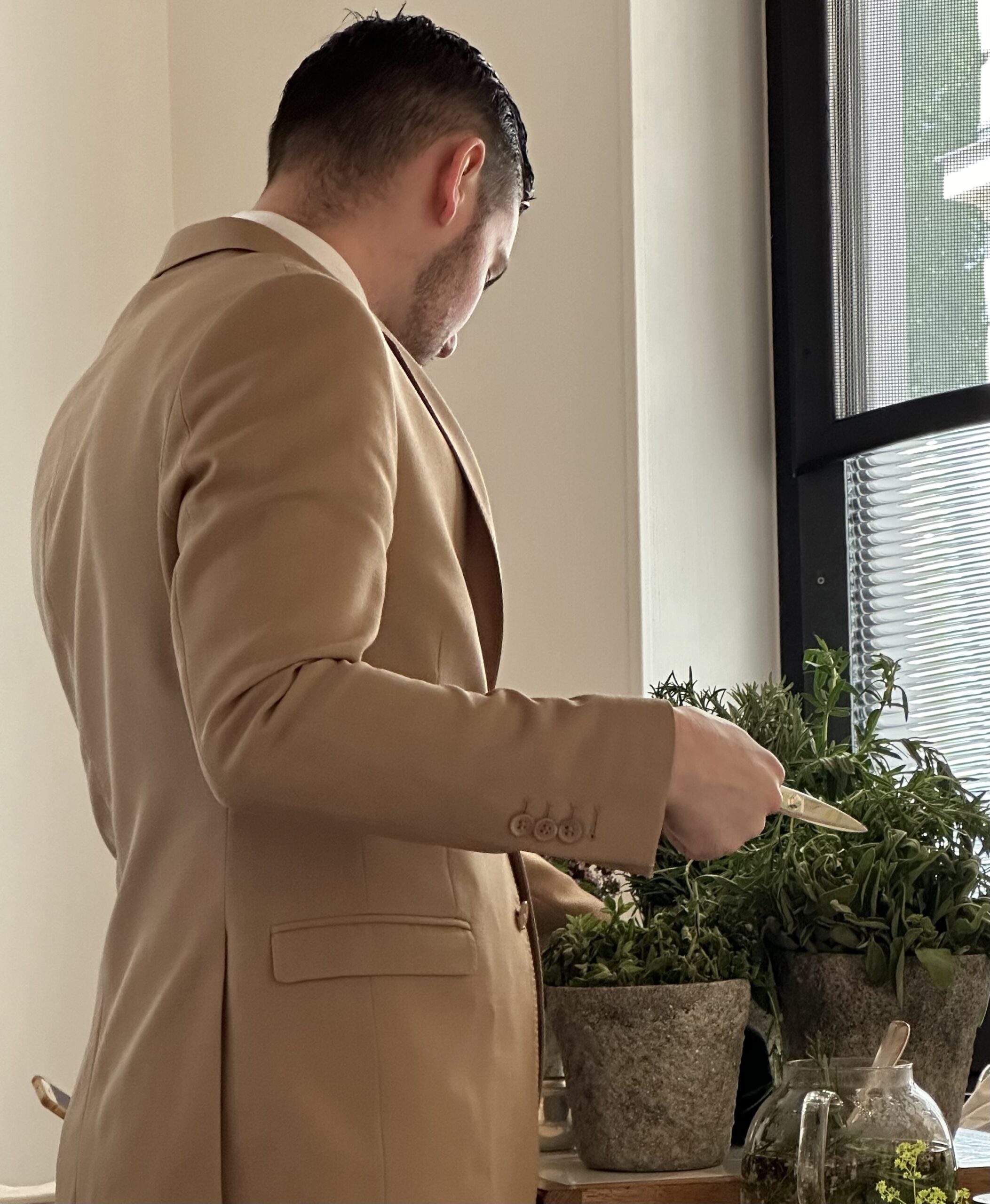
Elegantly dressed waiters cut fresh herbs table-side at L’Arpège. Photo by Marla Norman.
My experiences with vegetable plates in other restaurants have all been decent, but all kind of tasting the same. Not here! If you cannot conceive of being interested in a multi-course vegetable based menu, L’Arpège will surprise you in the best way.
The Chef: In most high end restaurants I have visited, the Chef always comes out of the kitchen to greet his/her clients and Alain Passard does as well. Impeccable, all smiles. Impossible to resist his energy and we don’t. After taking a few pics with him, I cannot not help thinking of the intelligence of that man. The restaurant’s front house is seamlessly managed, with extremely well trained staff. And then, the dishes each surpass the previous one. Yes, the prices are exorbitant. No, there are no steaks or food you normally expect from a 3-star Michelin restaurant. But, if you have the opportunity for a once or twice in a lifetime experience in ultimate food pleasure, this is it.
A final thought: Here in a single block of Paris are the works of a famous artist, Rodin, known worldwide, and this amazing restaurant exalting the work of another artist, Alain Passard!

Alain Passard, Chef-Owner at L’Arpège, with another very happy diner.
Click here to see more of our favorite Parisian restaurants.
MUSÉE RODIN & JARDIN DE SCULPTURE
On the same block, directly across the street from restaurant L’Arpège is one of the world’s greatest sculpture gardens: Musée Rodin. What could be more perfect after dining on Alain Passard’s inspired (and quite filling) cuisine than to take a stroll through the gardens and home of Auguste Rodin.
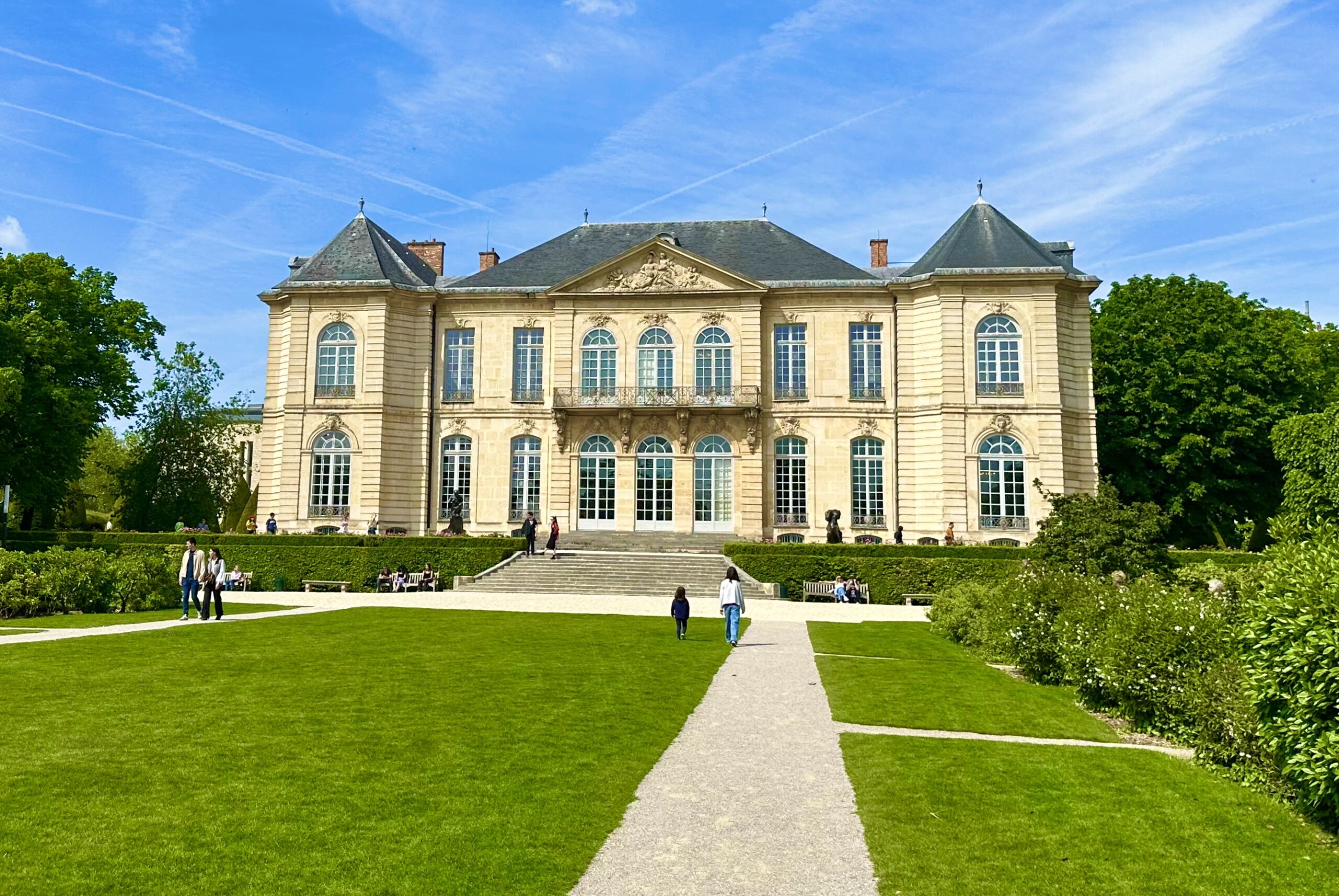
Musée Rodin – former home of sculptor Auguste Rodin
In the late 1800’s, when Rodin made his debut on the Paris art scene, depictions of non-aristocrats performing daily tasks were not considered art. Rodin’s powerful figures and unmistakable style changed all that.
As Michel and I enter the estate, the first major installation we encounter is “La Porte de l’Enfer” (The Gates of Hell). Maybe not the most welcoming sight, but significant since it sealed Rodin’s reputation as one of Europe’s top sculptors.
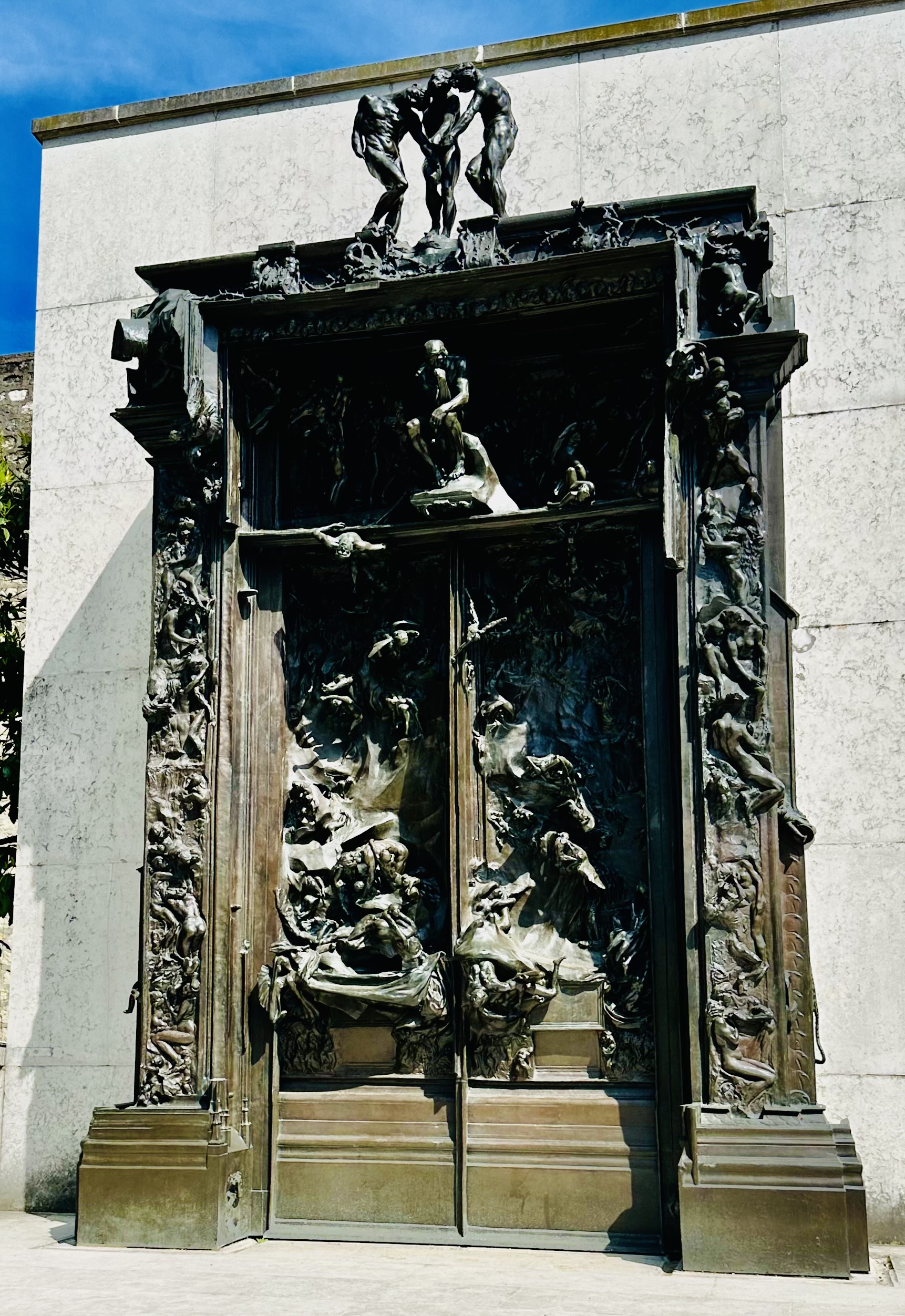
“La Porte de l’Enfer” (The Gates of Hell). See the original “Thinker” perched over the center of the doors. Photo by Marla Norman.
The enormous bronze panel is 19’ x 13’ and was originally designed to serve as the entrance to a new museum (which unfortunately was never built). A devoted fan of Italian writer Dante Alighieri, Rodin chose the “Divine Comedy” as the theme for his project. We study the tortured figures and admire the artistry, but…it’s such a lovely afternoon, spending time in Hell isn’t so appealing…
Interestingly, several of the sculptures from “The Gates of Hell” were enlarged and became works of art on their own, the most famous being “Le Penseur” (The Thinker). Representing both Dante and Rodin himself, the original figure was perched at the top of the Gates of Hell, pondering the agonies below him.
Currently, the life-size Thinker sits surrounded by roses and boxwood. Small children, flock to the statue’s pedestal and sit in imitation of the grand Penseur. Their faces and poses are as engaging as any of the world renowned sculptures. Undoubtedly Rodin would have approved.
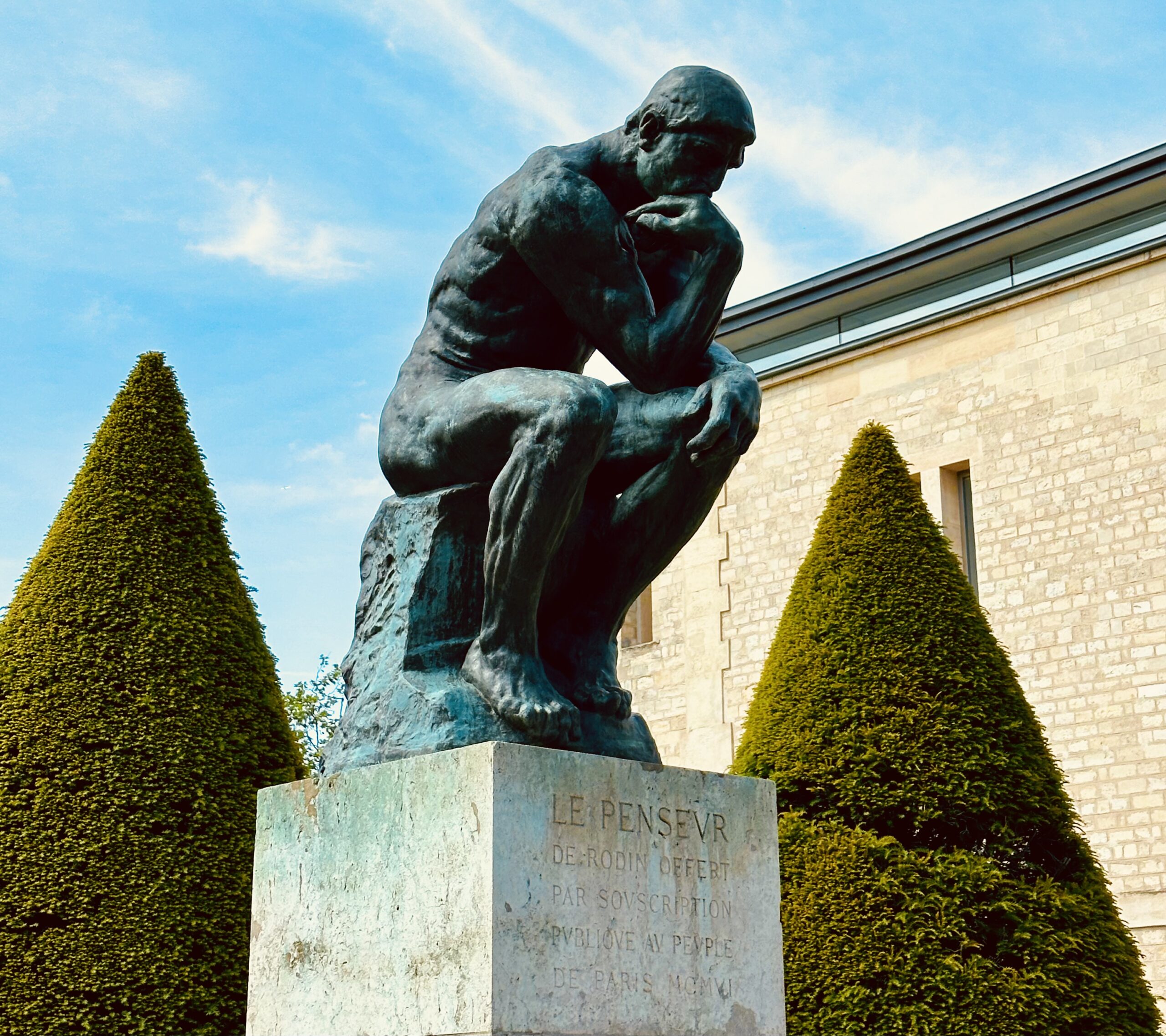
“Le Penseur” (The Thinker). Photo by Marla Norman
Also in the garden is one of Rodin’s most controversial works “Le Monument à Balzac” in memory of French novelist Honoré de Balzac. Here, Rodin sought to portray the writer’s scorn for convention and fashion clichés. But, the Société des Gens de Lettres de France, who commissioned the project, didn’t get it. They felt the sculpture was a hideous blob — disrespectful and insulting. In short order, they rejected the piece and “Le Balzac” sat at Rodin’s house until 1919. Some 22 years after his death, the statue was rescued and placed on display. Critics finally understood Rodin’s vision.
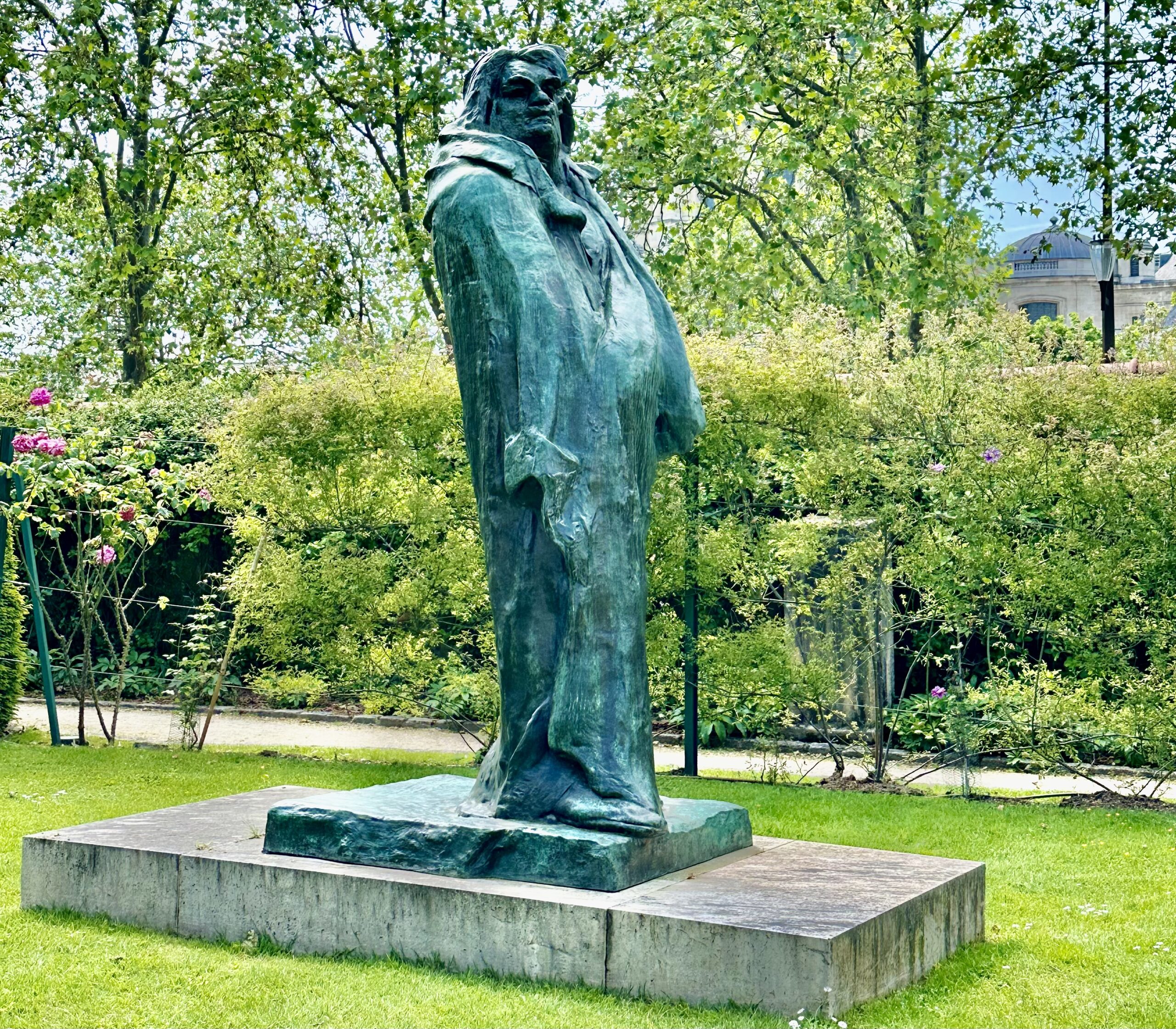
“Le Monument à Balzac” – tribute to the French novelist Honoré de Balzac.
Equally fascinating is “Les Bourgeois de Calais” (The Burghers of Calais) commemorating an event during the French Hundred Years War with England. (Caution! Almost 600 years after this war’s conclusion, it is still a very touchy subject for the French. Just ask Michel!)
Commissioned by the city of Calais, the sculpture was to commemorate the six city leaders who agreed to surrender in order to spare Calais. English King Edward III, demanded that the prisoners walk out wearing nooses around their necks while carrying keys to the city. Rodin’s sculpture depicts the anguish and heroic self-sacrifice of the Burghers.
But… just before they were to be hanged, the King issued a pardon. So, you’d assume these freed men were as elated and joyful in that moment as they had been desolate when they faced certain death. Yet, Rodin chose to depict the tragic, heart-wrenching version of the story. On this gorgeous summer afternoon, we wonder if the real-life ending wouldn’t have been just as moving. And better for French-English relations!
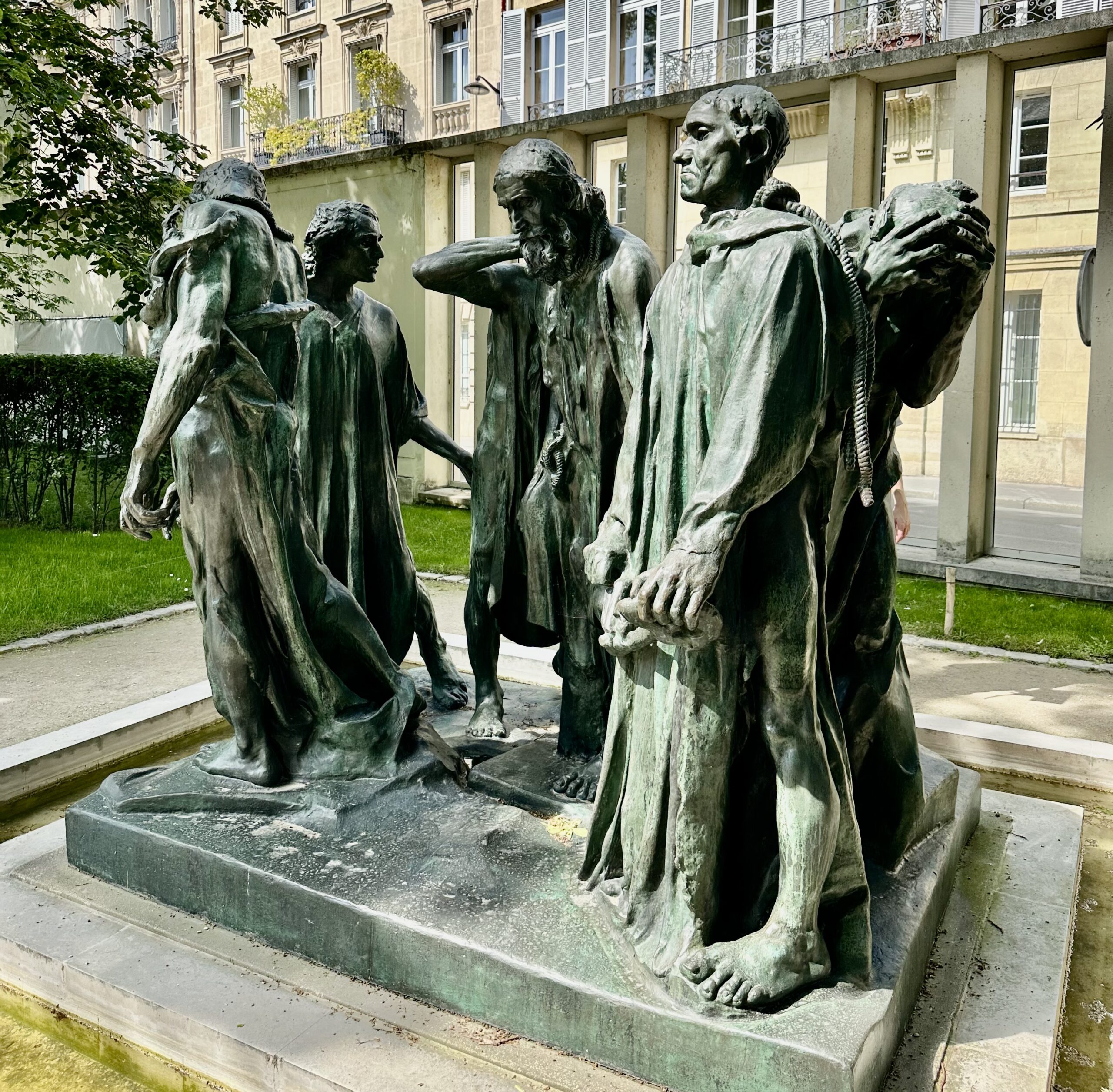
“Les Bourgeois de Calais” (The Burghers of Calais), with keys to the city and heavy nooses around their necks. Photos by Marla Norman.
In addition to the garden, visitors can see Rodin’s home. Here the main attraction is “Le Baiser” (The Kiss). Like “The Thinker” this sculpture was originally part of the “Gates of Hell.” Reproduced across the world and instantly recognizable, the embracing couple have come to represent ideal love.
The woman who modeled for Rodin’s “The Kiss” and many other figures, was his mistress, Camille Claudel. An extraordinarily talented artist in her own right, Claudel and Rodin were lovers for some ten years before ending their relationship. The two continued to collaborate, however, and Rodin supported Claudel financially until her work began to receive more acclaim than his own. From there the story is anything but romantic. Rodin used his influence to cancel Claudel’s projects. Eventually she wound up penniless and spent the last 30 years of her life in a mental asylum.
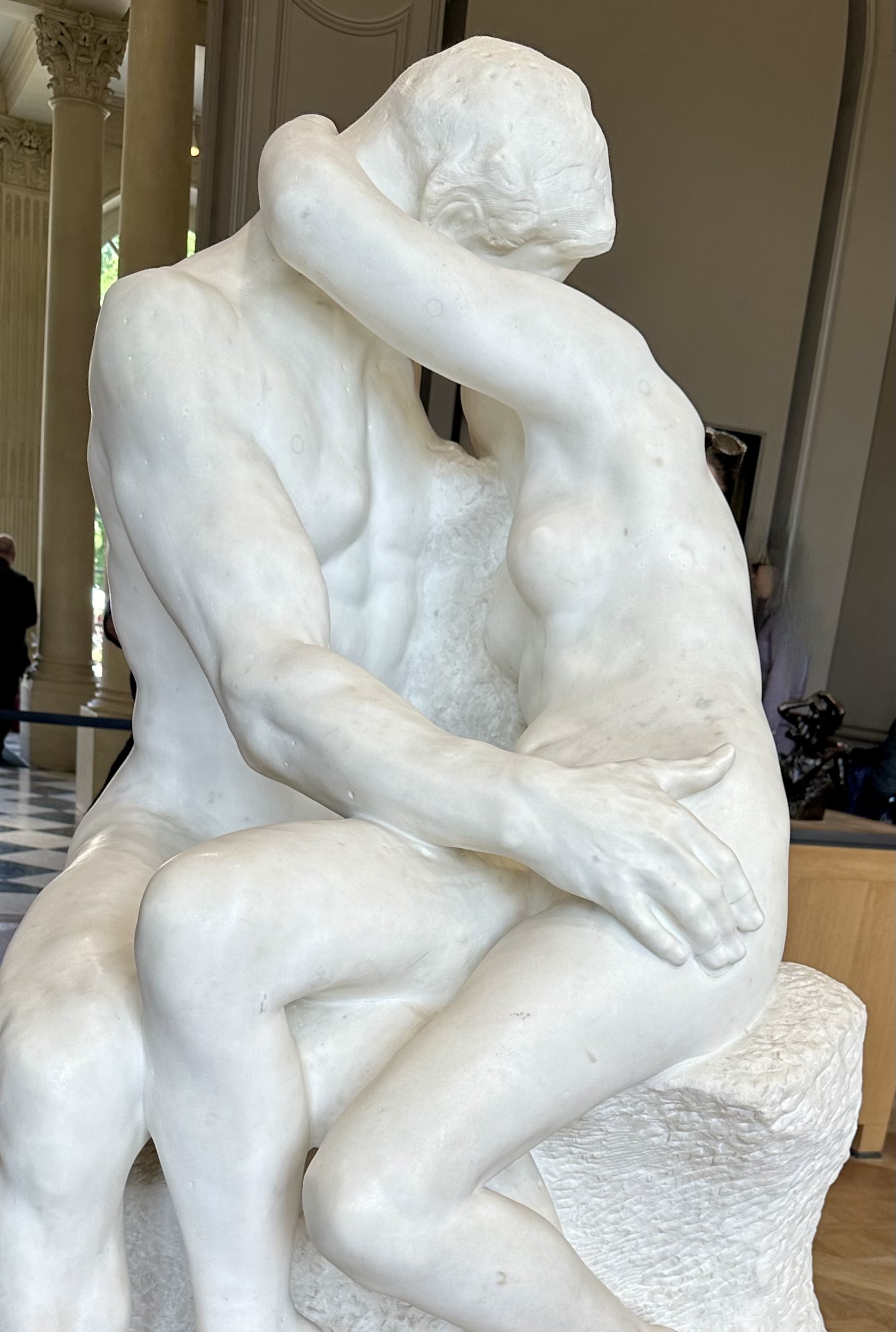
“Le Baiser” (The Kiss) – Two lovers forever locked in an embrace. Photo by Marla Norman.
Fortunately, “The Kiss” has had a life of its own and countless admirers. In fact, there are so many enthusiastic viewers today I can barely get a decent shot of the sculpture. Michel makes a quick exit and I dodge oncoming visitors to keep up with him.
We escape to a quiet corner of the garden and enjoy the calm. I give him a big squeeze.
“Oh! Was that artistic inspiration?” he jokes.
“Maybe,” I tell him. “But with so many people here, we can’t get too creative.”
“No worries,” he says grinning. “No one appreciates PDA like the French.” 😍🥰





